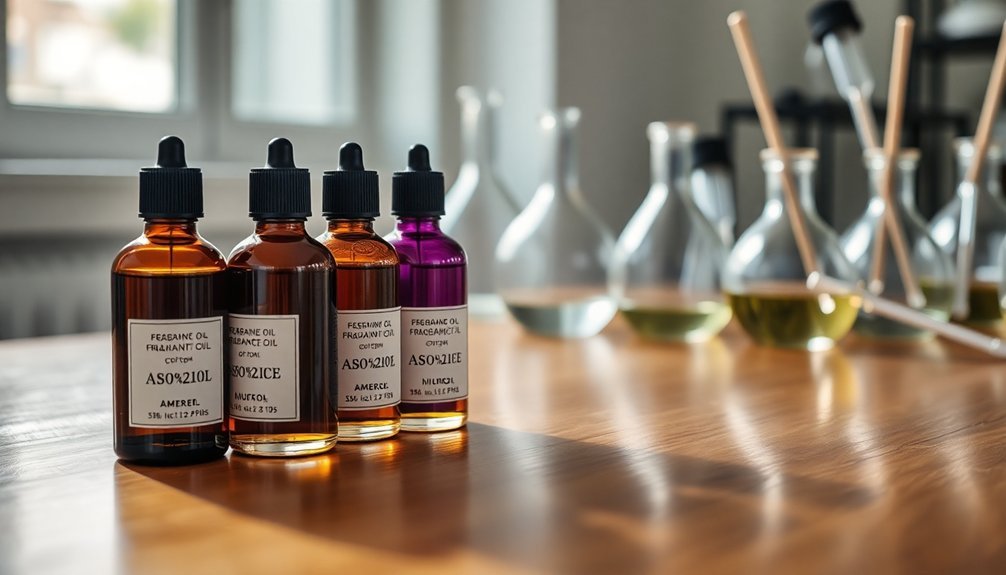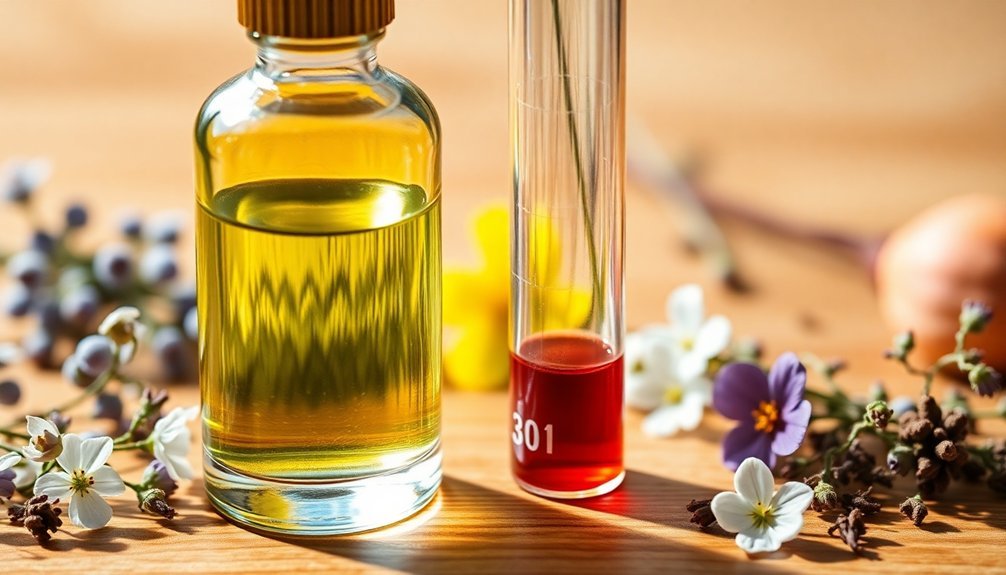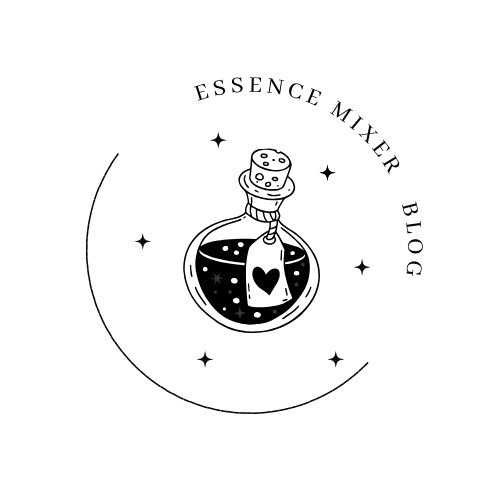Fragrance oils need proper dilution rates of 10-30% to guarantee your scents achieve the perfect balance of intensity and safety. When you dilute oils correctly, you'll get better scent throw, improved longevity, and enhanced compatibility with carrier oils. Different applications require specific concentrations – from 10-15% for personal care products to 20-30% for cosmetic formulations. Understanding these dilution basics will help you create professional-quality fragrances that perform exactly as intended.
Understanding Fragrance Oil Concentration Basics

When working with fragrance oils, understanding proper dilution rates is crucial for achieving the perfect scent intensity and stability in your final product.
You'll need to maintain a dilution rate between 10-30% to maximize the aromatic potential while guaranteeing safety and effectiveness.
Proper dilution serves multiple purposes in your formulations. It helps you control the scent throw and longevity of your fragrance oils while improving their compatibility with carrier substances.
You'll find that higher concentrations create stronger aromas, but they must stay within safe usage limits to prevent skin irritation.
Different fragrance notes respond uniquely to various concentration levels, so you'll need to adjust your dilution carefully to achieve your desired scent profile.
This careful balance guarantees your final product delivers peak performance while maintaining safety standards.
Safe Dilution Ranges for Different Skin Types
Your skin type directly determines how much fragrance oil you'll need to dilute for safe application, with sensitive skin requiring the lowest concentrations of 1-2%.
If you have normal skin, you can safely use dilutions between 2-3%, while those with oily or more resilient skin may tolerate concentrations up to 5%.
Before applying any fragrance oil blend, you should always perform a patch test first, regardless of your skin type, to guarantee you won't experience adverse reactions.
Sensitive Skin Dilution Guidelines
Since sensitive skin requires extra care and attention, understanding proper dilution rates is essential for safely using fragrance oils.
The maximum recommended dilution for sensitive skin is typically 1%, which equals about 5-6 drops of essential oil per ounce of carrier oil. If you're pregnant, have eczema, or are using oils on children, you'll want to stick to this lower dilution rate.
Key guidelines for sensitive skin:
- Start with a 1% dilution and monitor your skin's reaction
- Always perform a patch test 24-48 hours before full application
- Consider gradually increasing to 2% only if your skin shows no signs of irritation
Normal Skin Concentration Levels
Most people with normal skin can safely use fragrance oils at concentrations between 10-30%, offering greater flexibility compared to sensitive skin types.
You'll find that if your skin isn't particularly reactive, you can experiment with higher concentrations around 20-30% for body applications.
When you dilute essential oils, however, you'll need to follow stricter guidelines.
Keep facial applications at a maximum 2% dilution, while body applications shouldn't exceed 10%. This helps prevent adverse reactions while maintaining the product's effectiveness in your skin care routine.
Remember to take into account your overall health and any underlying conditions before choosing a concentration.
While your skin may handle higher percentages well, it's smart to start with lower dilutions and gradually increase them to guarantee your skin responds positively.
Oily Skin Percentage Ratios
When managing oily skin types, proper dilution ratios become particularly important to prevent excess sebum production and potential breakouts.
You'll need to be mindful of different dilution rates depending on whether you're using essential oils or fragrance oils with your carrier oils.
For oily skin, follow these key ratios:
- Essential oils: Use a 1-2% dilution rate (6-12 drops per ounce of carrier oil)
- Fragrance oils: Apply a 10-15% dilution for ideal scent without irritation
- Sensitive oily skin: Start at 1% dilution and increase gradually if no reactions occur
These specific dilution rates guarantee you're getting the benefits of your chosen oils while maintaining skin balance.
If you're dealing with combination skin, adjust to a moderate 2-3% dilution to accommodate both oily and dry areas effectively.
Measuring and Mixing Fragrance Oil Ratios
Creating the perfect fragrance blend requires precise measurements and careful attention to dilution ratios. When you're mixing fragrance oils, you'll need to work within the 10-30% range to achieve ideal scent strength. This careful balance prevents overwhelming aromas while guaranteeing your blend delivers the desired impact.
To calculate your dilution rates accurately, you'll need to take into account your total volume first. For instance, if you're making a 100ml blend at 20% concentration, you'll mix 20ml of fragrance oil with 80ml of carrier oil.
Since fragrance oils vary in potency, you might need to adjust these ratios accordingly. Don't forget to use proper measuring tools like graduated cylinders or pipettes to maintain accuracy.
These precise measurements will help you create consistent, well-balanced fragrances every time you blend.
Carrier Oil Selection for Optimal Scent Performance

Selecting the right carrier oil forms the foundation of a successful fragrance blend. You'll want to choose a carrier oil that enhances your essential oils without competing with their natural scents. The ideal maximum dilution rates range from 10% to 30%, depending on your intended use.
Choose carrier oils wisely – they're the silent partners that let essential oils shine without stealing the spotlight.
For maximum scent performance, consider these key factors:
- Scent neutrality – Oils like grapeseed and sweet almond won't interfere with your fragrance profile.
- Skin compatibility – Jojoba oil mimics your skin's natural sebum, making it an excellent carrier choice.
- Cost-effectiveness – Coconut and olive oils offer great benefits at budget-friendly prices.
Your carrier oil choice impacts both the fragrance's performance and your skin's health. Focus on finding the perfect balance between absorption rate, scent compatibility, and overall value.
Common Mistakes in Fragrance Oil Dilution
Understanding fragrance oil dilution can be challenging, even with the right carrier oil selection.
You'll often find yourself making common mistakes that can affect your final product's quality and safety. One critical error is assuming you can use fragrance oils without proper dilution rates, which can lead to skin irritation and overwhelming scents.
You might also struggle with accurately calculating dilutions based on your total formulation weight, resulting in concentrations that are either too strong or too weak.
Don't forget that different fragrance oils require varying dilution percentages to maintain their intended scent profile.
Another mistake you're likely making isn't considering evaporation rates when determining initial concentrations.
Most importantly, you should always patch test diluted fragrance oils before full application to prevent adverse skin reactions.
Professional Standards for Perfume Concentration

When perfumers develop fragrances for commercial use, they must adhere to established concentration standards that define the strength and classification of each scent.
Professional standards guide the dilution rates of fragrance oils to guarantee both safety and peak performance.
The industry recognizes these key concentration categories:
- Eau de Toilette: Contains 5-15% fragrance oils, making it suitable for everyday wear
- Eau de Parfum: Features 15-20% fragrance oils, offering a stronger, longer-lasting scent
- Parfum/Extrait: Includes 20-40% fragrance oils, requiring careful dilution for safe use
You'll find that these professional standards align with IFRA guidelines, which recommend diluting higher concentrations to prevent skin sensitivity.
Longevity and Sillage at Various Dilution Levels
You'll notice significant differences in your fragrance's performance when adjusting dilution rates between 10-30%, as higher concentrations directly impact both strength and projection.
Your fragrance's sillage becomes more pronounced at higher dilution levels within this range, creating a more enveloping scent experience that lingers in your space.
When you experiment with various dilution percentages, you'll find the sweet spot where your fragrance maintains ideal strength over time while achieving the desired projection level.
Strength Over Time
The concentration of fragrance oils directly impacts how long your scent will last and how far it'll project throughout the day.
When you're selecting the right dilution rate for your fragrance oils, you'll want to take into account how the strength changes over time.
Here's what happens at different concentration levels:
- At 10-15% dilution, you'll get a lighter scent that's gentler on your skin but may need reapplication.
- Between 15-25%, you'll achieve ideal sillage and longevity, allowing the fragrance to develop naturally throughout wear.
- At 25-30%, you'll experience the strongest projection, but you'll need to be cautious about potential skin sensitivity.
Higher dilution rates don't always mean better performance.
You'll find the sweet spot for most fragrance oils falls within the 15-25% range, balancing both safety and scent impact.
Scent Projection Analysis
Analyzing scent projection requires understanding both longevity and sillage across different dilution levels.
When you're working with fragrance oils, you'll find that the dilution rate greatly impacts how your scent performs throughout the day.
At higher dilution levels between 10-30%, you'll notice your fragrance develops more complexity as the subtle notes emerge gradually.
While concentrated formulations might give you an intense initial burst, they don't always translate to better longevity.
Instead, properly diluted oils allow for a more graceful evolution of the scent over time.
You'll also discover that sillage varies considerably based on concentration.
Customizing Dilution Rates for Different Applications

When working with fragrance oils, understanding how to customize dilution rates for specific applications becomes crucial for achieving excellent results.
Mastering fragrance oil dilution is essential for creating perfectly balanced scents across different product applications.
You'll need to balance the desired scent intensity with safety considerations, particularly when it comes to skin sensitivity. Different applications require varying concentrations to perform effectively.
Here's what you should consider for common applications:
- Personal care products: Keep dilution rates between 10-15% to protect sensitive skin while maintaining fragrance effectiveness.
- Home fragrances: Use 10-20% dilution for candles and diffusers to achieve effective scent throw.
- Cosmetic formulations: Stay within 20-30% dilution to guarantee both safety and pleasant fragrance intensity.
Remember to always test your dilutions on a small scale first, as individual fragrance oils may vary in potency and require adjustment within these recommended ranges.
Frequently Asked Questions
What Is the 30/50/20 Rule for Perfume?
You'll want to blend your perfume using the 30/50/20 rule: 30% top notes for initial impact, 50% middle notes for the heart of your fragrance, and 20% base notes for lasting depth.
How Much Should Fragrance Oil Be Diluted?
You'll need to dilute fragrance oils between 10-30% for general use. For skin contact, stick to 2% (12-18 drops per ounce), while candle making requires 10-20% of wax weight for ideal results.
What Is the 30/50/20 Rule for Essential Oils?
The 30/50/20 rule guides you in blending essential oils: use 30% top notes for initial scent, 50% middle notes for the main body, and 20% base notes for lasting depth in your fragrance blend.
Is 10% Fragrance Oil Too Much?
Yes, a 10% fragrance oil concentration is too strong for skin products. You'll want to keep it between 2-5% for skincare to avoid irritation. For candles or home fragrances, 10% can work well.
In Summary
You'll find that proper fragrance oil dilution between 10-30% isn't just about safety – it's essential for achieving the perfect scent performance. By understanding your skin type, selecting appropriate carrier oils, and following professional concentration standards, you're able to create long-lasting fragrances that won't overwhelm. Remember to test small batches first and adjust your ratios until you've found your ideal balance.





Leave a Reply